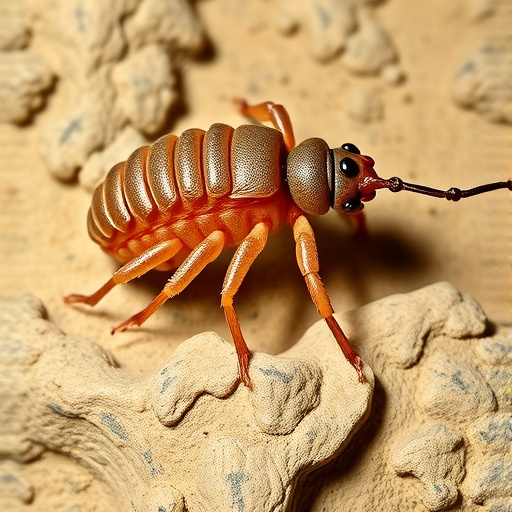In a groundbreaking exploration of the enigmatic creature known as Archaeoniscus brodiei, researchers have ventured into the depths of Early Cretaceous marine environments to unravel the complexities of its morphology and taphonomic history. This gregarious isopod, which thrived approximately 145 to 100 million years ago, provides a unique view into prehistoric ecosystems and the evolutionary pathways that shaped modern crustaceans. The insights gained from this study not only deepen our understanding of this ancient organism but also shed light on broader ecological dynamics during a pivotal era in Earth’s history.
The morphology of Archaeoniscus brodiei reveals a host of unique physical attributes that have fascinated paleontologists. With its distinct body structure characterized by an elongated shape, dorsal carapace, and specialized appendages, this isopod exhibits features that suggest ecological adaptations which enabled it to thrive in its marine habitat. Researchers meticulously examined fossils from various locations that have preserved these delicate features, offering a glimpse into the evolutionary pressures that shaped its design.
The research team, led by experts in paleontology and taphonomy, employed advanced imaging technologies to capture the intricate details of Archaeoniscus brodiei. Utilizing high-resolution computed tomography (CT) scans, they were able to visualize internal structures and better understand the complexities of its anatomy. This non-destructive technique gave new life to fossils that might otherwise remain enigmatic, facilitating a comprehensive analysis of the creature’s biological functions and ecological role.
Another significant focus of this study involves the taphonomic processes that affected the preservation of Archaeoniscus brodiei specimens. Taphonomy, the study of how organisms decay and become fossilized, plays a critical role in paleobiological research. By analyzing sedimentary contexts and diagenetic factors, researchers were able to reconstruct the circumstances under which these isopods were buried and preserved. Such insights illuminate the environmental conditions of the Early Cretaceous period and help contextualize the living conditions of aquatic life during that time.
The findings suggest that Archaeoniscus brodiei likely inhabited shallow, coastal environments where it could exploit various ecological niches. The fossil record indicates a high degree of gregarious behavior, with evidence of aggregations that may have served various purposes, such as protection from predators or fostering reproductive success. This aspect of their behavior raises intriguing questions about the social structures and interactions of Early Cretaceous isopods, drawing parallels with contemporary crustaceans in similar habitats.
Through the analysis, researchers also touched upon the dietary habits of Archaeoniscus brodiei. Preliminary examinations of coprolites associated with these isopods indicate a diet that may have included detritus and organic matter, showcasing their role as scavengers within their ecosystems. This information is crucial to understanding the dietary strategies employed by ancient marine organisms and the ecological roles they played in nutrient cycling within their environments.
The implications of this research extend far beyond mere fossil analysis. By uncovering the biological and ecological intricacies of Archaeoniscus brodiei, the study contributes to the broader narrative of marine biodiversity and the evolutionary history of crustaceans. The evolutionary lineage of isopods is integral to understanding the adaptive radiation that led to the diversity we observe today. Such insights are invaluable in a time when marine ecosystems are facing unprecedented challenges due to human activity, climate change, and habitat loss.
Furthermore, the collaboration between researchers from various disciplines emphasizes the importance of multidisciplinary approaches in paleontological studies. The integration of paleobiology, sedimentology, and imaging technology reflects the need for diverse expertise in unraveling the complexities of fossil organisms and their environments. This collaborative spirit is essential for advancing our understanding of past life forms and their evolution.
As we move forward, the study of Archaeoniscus brodiei acts as a salient reminder of the intricate tapestry of life that has existed on our planet. Each fossil unearthed is a narrative waiting to be told, adding another thread to the rich history of Earth’s biological heritage. This research not only satisfies our curiosity about ancient life but also underscores the importance of conserving the biodiversity that remains today.
In conclusion, the exploration of Archaeoniscus brodiei serves as an important contribution to our understanding of Cretaceous marine life. Through meticulous study and advanced technologies, researchers are piecing together the life story of this ancient isopod, revealing its morphological nuances and ecological significance. The findings presented illuminate the interconnectedness of life forms across geological time and compel us to appreciate the delicate balances that sustain biodiversity, both past and present.
As researchers continue to delve into the depths of paleontology, studies like this pave the way for further discoveries that challenge our understanding of evolutionary biology. Each fossil holds a key to our past, and through rigorous investigation, we can unlock the mysteries of our planet’s ancient ecosystems. The legacy of Archaeoniscus brodiei is not merely one of extinction; it is a testament to the enduring complexity and resilience of life throughout Earth’s history.
This ongoing research elevates our appreciation for the incredible diversity once present in Earth’s primordial oceans and serves as a call to action to protect and conserve the precious ecosystems that exist today. In a world facing ecological uncertainty, the tale of Archaeoniscus brodiei encourages us to reflect on our stewardship of the planet and the legacy we wish to leave for future generations.
As more discoveries emerge from the fossil record, the story of life on Earth continues to unfold, inviting us to marvel at the rich history that has shaped our present. Archaeoniscus brodiei is just one of many fascinating life forms that tell the story of survival, adaptation, and the intricate dance of ecosystems through time.
Subject of Research: Morphology and taphonomy of Archaeoniscus brodiei
Article Title: Exploring the morphology and taphonomy of Archaeoniscus brodiei—a gregarious, Early Cretaceous isopod
Article References:
Bicknell, R.D.C., Klompmaker, A.A., Smith, P.M. et al. Exploring the morphology and taphonomy of Archaeoniscus brodiei—a gregarious, Early Cretaceous isopod. Sci Nat 112, 16 (2025). https://doi.org/10.1007/s00114-025-01962-8
Image Credits: AI Generated
DOI: https://doi.org/10.1007/s00114-025-01962-8
Keywords: Paleontology, Isopod, Early Cretaceous, Morphology, Taphonomy, Ecology, Marine Biodiversity, Evolution




